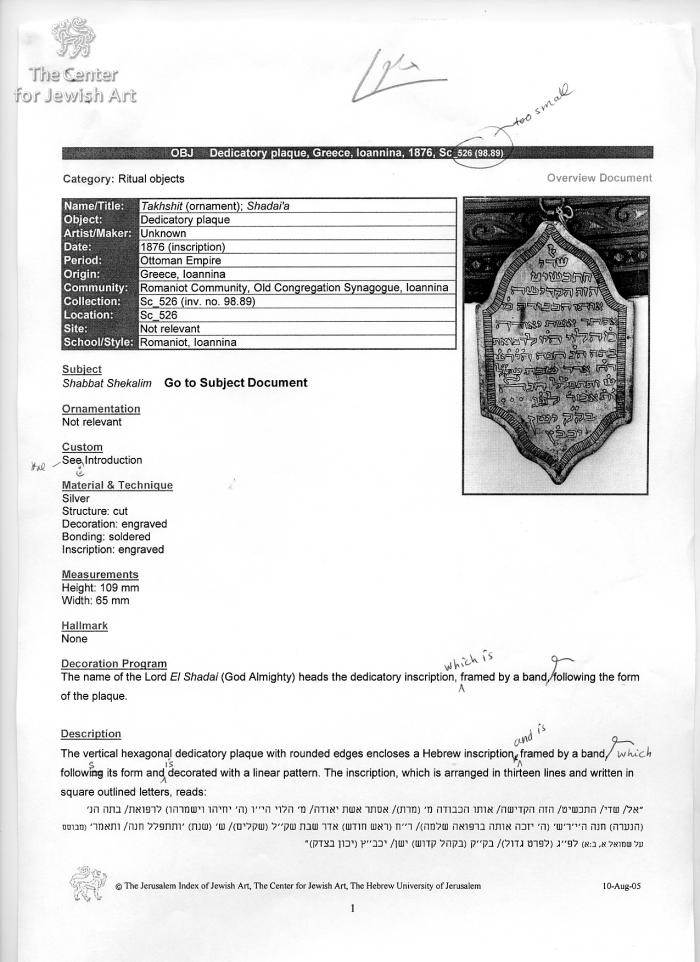Img. ID: 35660

The vertical hexagonal dedicatory plaque with rounded edges encloses a Hebrew inscription, and is framed by a band, which follows its form and is decorated with a linear pattern. The inscription is arranged in thirteen lines and written in square, outlined letters, reads:
"אל/ שדי/ התכשיט/ הזה הקדישה/ אותו הכבודה מ' (מרת)/ אסתר אשת יאודה/ מ' הלוי הי''ו (ה' יחיהו וישמרהו) לרפואת/ בתה הנ' (הנערה) חנה ה'י'ר'ש' (ה' יזכה אותה ברפואה שלמה)/ ר''ח (ראש חודש) אדר שבת שק''ל (שקלים)/ ש' (שנת) 'ותתפלל חנה/ ותאמר' (מבוסס על שמואל א, ב:א) לפ''ג (לפרט גדול)/ בק''ק (בקהל קדוש) ישן/ יכב''ץ (יכון בצדק)"
"El Shadai (God Almighty), this ornament was dedicated by the respected Mrs. Esther, wife of Judah M. HaLevi (see Remarks no. 2), may the Lord sustain and protect him, for the recovery of her daughter the young girl Hannah, may the Lord provide her with a complete recovery. (Donated on) the New Moon of Adar, Shabbat Shekalim, the year 'And Hannah prayed, and said…' (based on Samuel 1, 1:2), to the Old Holy Congregation, may it be established with justice."
The sum of the letters of the verse ''And Hannah prayed, and said'' indicates the year 5636 (= 26.02.1876).
A loop with a suspension ring is attached to the top of the plaque.
Structure: cut
Decoration: engraved
Bonding: soldered
Inscription: engraved
the common custom in other communities, they were not attached to specific ritual objects at the time of the donation. When a large number of shadai'ot plaques were assembled in a synagogue they were sewn on to a parokhet. Some were also attached to Torah case wrappers or belts, which were probably hung along the walls of the synagogue on different occasions, and on parokhot. Although the events mentioned in the dedicatory inscriptions occurred at different times, the plaques were consistently donated to the synagogue on special days in the Jewish Year. The three pilgrimage festivals (Passover, Shavu'ot, Sukkot) are common, as well as Rosh Ha-shanah, Yom Kippur, Rosh Hodesh (the New Moon) and Sabbaths. Rarely does the date of the donation mentioned on the plaque indicate another day of the week.
The custom was practiced among the Romaniot communities of Arta, Ioannina, Previzia, and is still practiced in Trikala and Larissa. No differences were noticeable between the two congregations in Ioannina concerning shape, dedicatory formulas or names of donors. The only distinction between the Old and New Holy Congregations is the name of the synagogue (when it appears). Most shadai'ot from Trikala and Larissa, documented recently, differ from the others and are shaped as Stars of David enclosed within circles. Few of them maintain the early linguistic dedicatory formulas.
The name of the Lord El Shadai (God Almighty) heads the inscription, enclosed within the dedicatory plaque, framed by a band, which follows the plaque's form.
- The word "El" is a ligature.
- The name "יהודה" (Judah) is misspelled according to the local pronunciation "יאודה" (Ye'udah).
-
Shabbat Shekalim is the first of the four special Sabbaths, which are marked by the reading of an additional portion from the Pentateuch. The rite of these special Sabbaths is conducted during four successive weeks: Shabbat Shekalim – on the New Moon of Adar or the closest Sabbath to it; Shabbat Zakhor – the Sabbath preceding Purim; Shabbat Parah (the Red Heifer) – the Sabbath following Purim and the last is Shabbat Ha-Hodesh – the Sabbath which designates the New Moon of the month of Nisan. The portion read on Shabbat Shekalim is "When thou takest" ("Ki Tisah" Ex. 30:11-16), which relates to the collection of half a shekel from every male above the age of twenty for the redemption of his soul and for the census of the Israelites. For the custom of donating the plaques on a special Sabbath see Custom.
- This plaque is one of eleven plaques dating from 1771 till 1876, attached to belt no. 60. The choice of the plaques sewn to the belts appears to be random. They were usually attached when there was a large collection of plaques in the synagogue.
The plaque was purchased by the museum from the Jewish community of Ioannina on 29.06.98.



